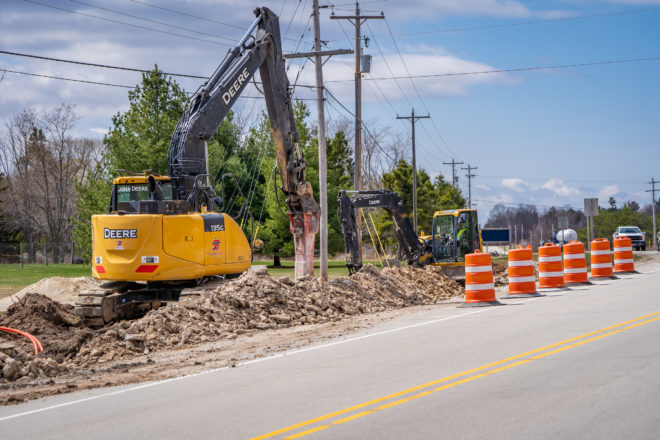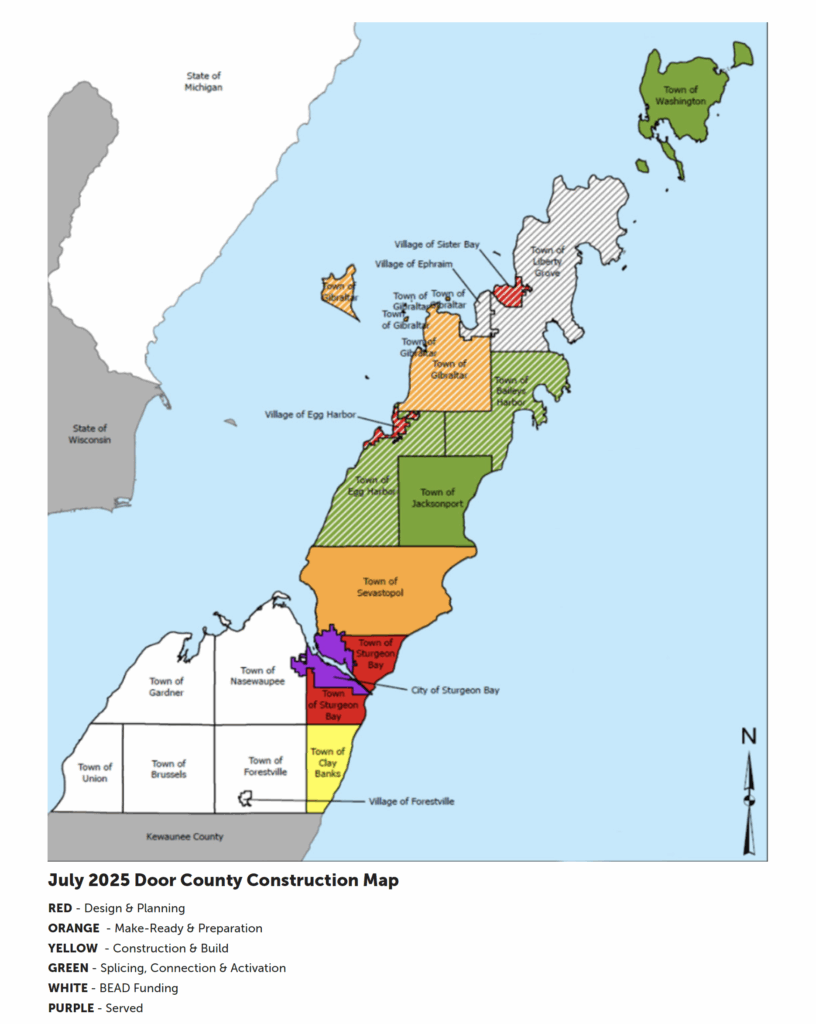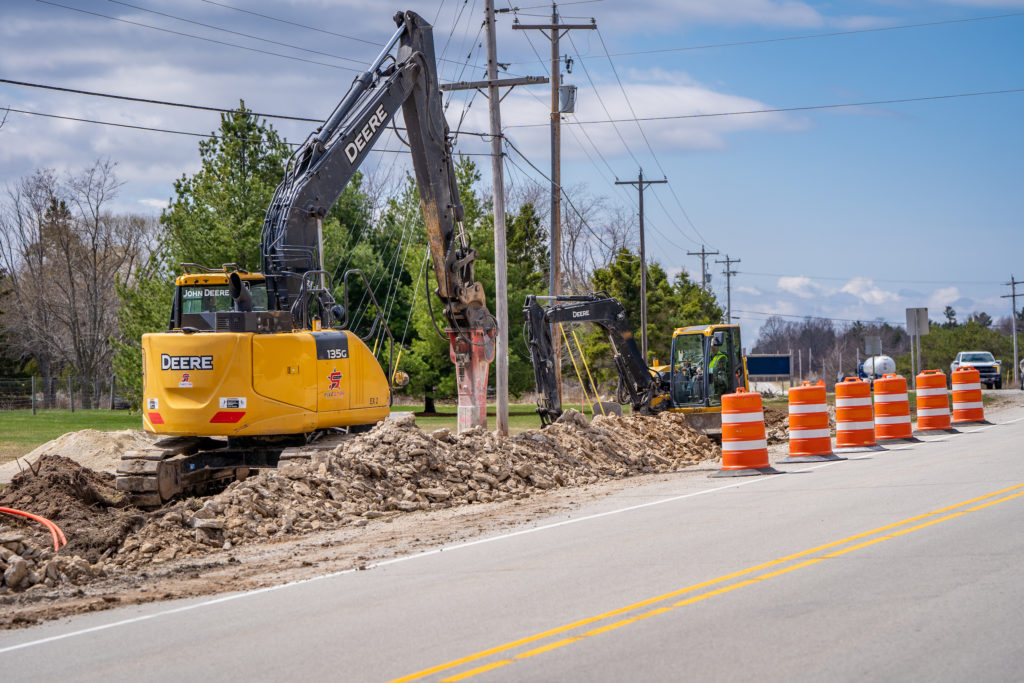
Bertram Communications is one of several companies that have been expanding fiber networks in Door County, many funded in part by federal grants. File photo by Rachel Lukas.
Guidelines for broadband deployment changed after the Trump Administration, causing a pause and a regrouping period in the federal Broadband Equity, Access and Deployment (BEAD) program. However, broadband expansion projects in Door County are still progressing.
“We’ve lost maybe two or three months,” said Jessica Hatch, Door County’s broadband coordinator.
The BEAD program was created under the Bipartisan Infrastructure Law to expand high-speed internet access nationwide. Wisconsin was allocated $1,055,823,574 through the program, which had reached the award phase earlier this year. In its first funding round, the Public Service Commission of Wisconsin (PSC) awarded $540 million to projects serving over 103,000 eligible locations.
“From my understanding, a majority of our project awards had been awarded,” under that round, Hatch said, though they had not been made public.
That changed in early June, when the National Telecommunications and Information Administration (NTIA) ordered the PSC to rescind all preliminary awards and halt the process. As a result, no new awards were made from the second round’s 259 applications.
Following the pause, the BEAD program was restructured. A new application process, called Benefit of the Bargain (BOB), reopened on July 17.
In Door County, BEAD-eligible communities include southern Door County, as well as the Village of Ephraim and the Town of Liberty Grove in the north (see related map). The rest of the county – excluding the City of Sturgeon Bay, which is considered fully served – is continuing at various stages, supported by grants and partnerships with internet service providers (ISPs).
 This map shows the status of broadband projects across Door County.
This map shows the status of broadband projects across Door County.
The municipalities in white – southern Door County, but also the Village of Ephraim and the Town of Liberty Grove in northern Door County – are eligible for BEAD (Broadband Equity, Access and Deployment program) funding. The others are in various stages of construction through previous grants received and public/private partnerships with Internet Service Providers.
In addition to the color-coding that shows the status, the hash marks/lines indicate areas where Frontier is also doing upgrades of its own. According to Jessica Hatch, Door County broadband coordinator, the company – which is being purchased by Verizon (see related story) – is upgrading its existing copper footprint to deploy broadband fiber access to up to 4,700 locations in Door County. Hatch said she understood that buildout was supposed to be finished by this year’s end.
Frontier acknowledged receipt of Peninsula Pulse questions about its work, but had not responded by our deadline.
Under the BEAD framework, ISPs bid on geographic project “units,” each containing a group of eligible locations. Door County has been divided into 60 such units. To qualify, ISPs must commit to serving all locations within a unit using the same technology at uniform speeds.
According to Hatch, 11,621 locations in Door County – residential and business – are already funded for fiber-to-the-premises (FTTP) through existing grants and public/private partnerships. That leaves 9,048 locations remaining to be served (excluding the city, which has 4,584 served locations). Of the remaining locations, 6,056 are eligible for BEAD funding, leaving 2,992 locations outside the scope of both BEAD and current FTTP funding.
Changes during the BEAD restructuring included the removal of nondiscrimination requirements and equity language, such as terms like “climate resiliency,” “open access,” “net neutrality,” and “middle class affordability,” according to a listing of the program changes Hatch prepared. She said one of the most significant changes in the restructured program is its shift to a technology-neutral approach. Previously, the program prioritized fiber infrastructure. Door County had aligned with this focus ever since its countywide broadband assessment, released in December 2021, recommended fiber as the preferred delivery method.
Now, awards will go to the lowest-cost solution that meets the program’s baseline requirements – regardless of technology.
“We do not know which technology is the lowest cost to deploy in any of the project units,” Hatch said. “The Wisconsin Broadband Office does not even know that. They will determine what the lowest cost to deploy broadband is for each individual project unit based on the applications that will be submitted.”
To qualify, the proposed service must deliver minimum speeds of 100/20 Megabits per second (Mbps) download/upload to all unserved households and businesses in a unit. Installations must be standard, and monthly service costs must not exceed $200.
Hatch said the new guidelines give ISPs more flexibility and simplify vendor approval, allowing a wider range of providers to participate. In Wisconsin, 41 ISPs are currently eligible to bid.
“There are only a certain number of entities interested in bidding on our area,” Hatch said. “We’re not going to see a provider who doesn’t already have a network here because it’s too expensive.”
ISPs with enough of a regional footprint to realistically bid on Door County units include Bertram, Frontier, Brightspeed, AT&T, Bug Tussel, Nsight, and Starlink, she said.
Whether the outcome will serve residents well remains to be seen – especially in areas like Door County, where terrain and geography impact service quality.
“That’s why we had the fiber-forward focus, because other tech struggles,” Hatch said. “Fixed wireless is great – it works great for us at my house. But a lot of that tech has to be refreshed with equipment changes and updates. So the focus on fiber was to kind of break that chain.”
The BOB application period opened July 17. Final proposals will be submitted to NTIA by Sept. 4 for review and approval. Hatch said she expects to know by the end of the year which awards have been made for Door County.
Verizon Purchasing Frontier
Verizon is purchasing Frontier, an acquisition approved by the Federal Communications Commission (FCC) on May 16, 2025. Verizon is paying $9.6 billion for the company and agreed to take on $10 billion in Frontier debt, according to the FCC, which concluded the transaction serves public interest, convenience and necessity.
In a press release, Brendan Carr, FCC chairman, said Americans will benefit from the merger.
“The transaction will unleash billions of dollars in new infrastructure builds in communities across the country, including rural America,” Carr said in the statement. “This investment will accelerate the transition away from old, copper line networks to modern, high-speed ones. And it delivers for America’s tower and telecom crews who do the hard, often gritty work needed to build high-speed networks.”
The FCC said the transaction allows Verizon to upgrade and expand Frontier’s existing network in 25 states, bringing more fiber to more communities. Following the transaction, Verizon expects to deploy fiber to 1 million or more American homes annually.
According to the FCC document, Frontier emerged from bankruptcy in 2021 and shifted to a fiber-first strategy, targeting the passage of 10 million locations nationwide by 2026. Frontier is on track to complete that plan, according to the document, having passed 7.2 million locations as of August 2024, but “it does not have funding in place for further investment or additional fiber buildouts beyond that point.”
In addition, the company incurred a significant amount of debt as a result of its efforts, making it hard for the company to take on more to continue its fiber investments.
–Debra Fitzgerald

